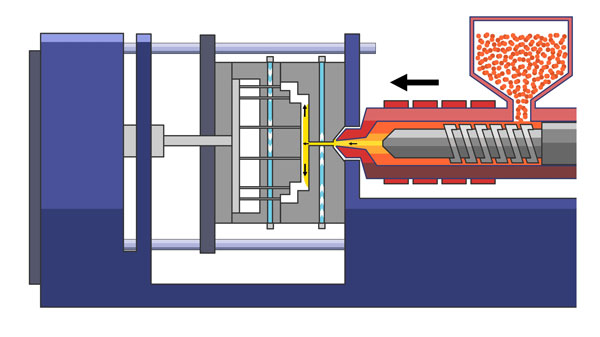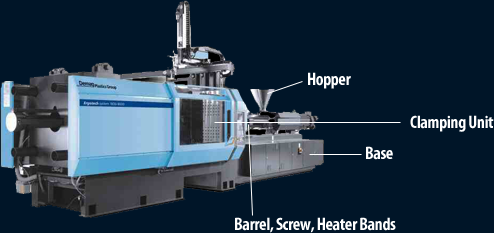Mfg for Dummiess
Wiki Article
Little Known Facts About Die Casting.
Table of ContentsSome Known Questions About Additive Manufacturing.Facts About Hon Hai Precision Uncovered9 Simple Techniques For Lean ManufacturingGet This Report about Die CastingThe Ultimate Guide To ManufacturingThe 8-Minute Rule for Hon Hai Precision
The text on this page is a sample from our full White Paper 'Injection Moulding for Buyers' - * Sample message * - for complete overview click the download switch over! Intro This guide is meant for people that are looking to source plastic mouldings. It gives a much needed insight right into all that is entailed with developing plastic components, from the mould device needed to the moulding procedure itself.If you wish to check out even more, the overview covers kinds of mould devices, in addition to special finishing processes such as colours & plating. Words that are underscored can be found in the glossary in the appendix ... Part I: Moulding: The Essentials The Benefits of Shot Moulding Plastic shot moulding is an extremely precise procedure that offers a number of advantages over other plastic handling approaches.
Precision is perfect for very complex components. Contrasted to other methods, moulding permits you to include even more features at really small tolerances. Have a look at the picture to the right. lean production. You can hold this moulding in the palm of your hand and it has employers, ribs, steel inserts, side cores and openings, made with a sliding closed off feature in the mould tool.
The Facts About Lean Manufacturing Uncovered


from material feed Product melting; material injection; cooling time cooling down ejection to the re-closing of the mould tool ready for prepared next cycle. Draft angles - The wall surfaces of a moulded part need to be somewhat tapered in the instructions in which the part is expelled from the mould tool, to permit the part to be expelled easily.
Ejector stroke - The pressing out of ejector pins to eject the moulded component from the mould device. Ejector stroke rate, length and timing needs to be very carefully controlled to stop damages to the ejectors as well as mould tool, yet at the very same time make the moulding cycle as brief as feasible.

Top Guidelines Of Die Casting
Ribs - When a plastic part has thin walls, ribs are included in the layout to make the slim wall surfaces more powerful Side cores - Side activity which creates an attribute on a moulded component, at an opposing angle to the typical opening direction of the mould tool. hon hai precision. The side core requires to be able to withdraw as the plastic part can not be ejected or else.
Walls - The sides of a moulded component The text on this page is an example from our complete White Paper 'Shot Moulding for Purchasers'.
Manufacturing process for producing components by infusing molten material right into a mould, or mold Simplified layout of the procedure Shot moulding (U.S. punctuation: shot molding) is a manufacturing process for creating parts by infusing liquified material right into a mould, or mold and mildew. Injection moulding can be performed with a host of products generally including steels (for which the procedure is called die-casting), glasses, elastomers, confections, as well as a lot of generally thermoplastic and thermosetting polymers. Injection moulding is look at this site commonly used for making a variety of components, from the tiniest elements to whole body panels of cars and trucks. Injection moulding utilizes a special-purpose equipment that has 3 components: the shot unit, the mould and also the clamp.
The Buzz on Manufacturing
Process qualities [edit] Injection moulding makes use of a ram or screw-type bettor to compel liquified plastic or rubber product right into a mould dental caries; this strengthens into a form that has adapted the contour of the mould. It is most generally used to refine both polycarbonate as well as thermosetting polymers, with the volume use the previous being substantially higher.: 13 Thermoplastics prevail as a result of features that make them very appropriate for injection moulding, such as ease of recycling, versatility for a variety of applications,: 89 and also capability to soften and flow on heating.In multiple tooth cavity moulds, each dental caries can try this be identical as well as create the same parts or can be one-of-a-kind and develop numerous various geometries during a single cycle.
The screw supplies the raw material ahead, mixes and also homogenises the thermal and viscous distributions of the polymer, as well as lowers the required heating time by mechanically shearing the product and also including a significant amount of frictional Related Site home heating to the polymer. The product feeds forward through a check valve as well as accumulates at the front of the screw right into a volume called a shot. When enough material has gathered, the material is required at high pressure as well as speed right into the component developing dental caries. The specific quantity of contraction is a feature of the material being made use of, and can be relatively predictable. To stop spikes in pressure, the process typically utilizes a transfer setting representing a 9598% full cavity where the screw shifts from a constant rate to a continuous stress control.
Our Die Casting Statements
The packing pressure is applied up until the entrance (dental caries entry) solidifies. Due to its small size, the entrance is usually the initial area to strengthen with its whole thickness.: 16 Once the gateway solidifies, no even more product can enter the tooth cavity; appropriately, the screw reciprocates and obtains product for the following cycle while the material within the mould cools so that it can be ejected as well as be dimensionally secure.Report this wiki page